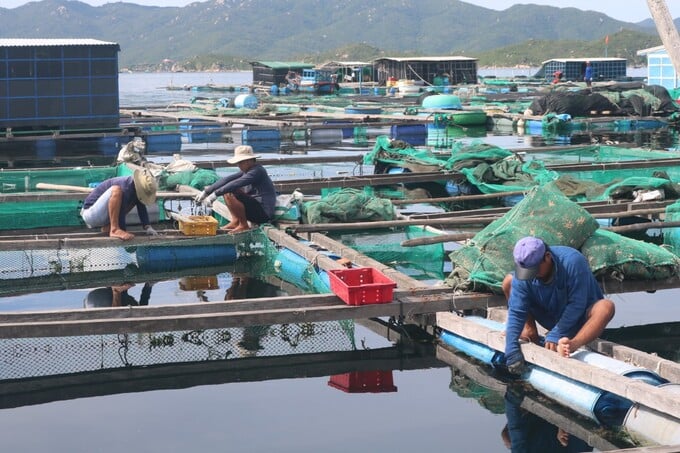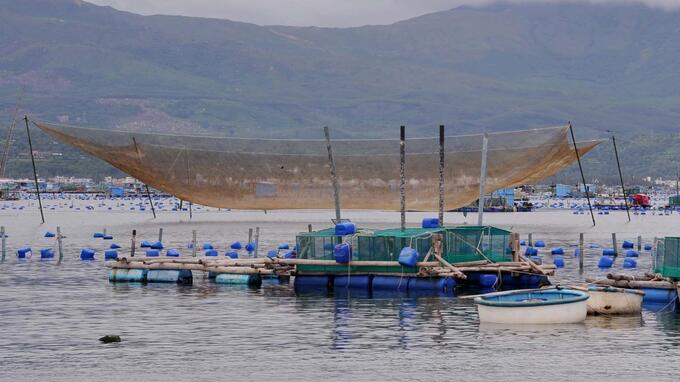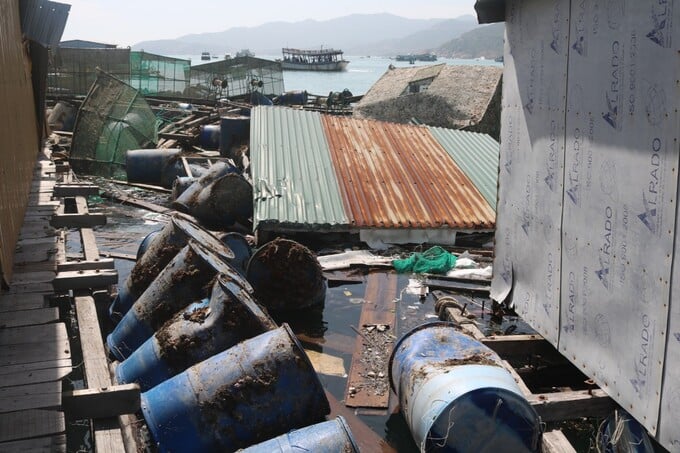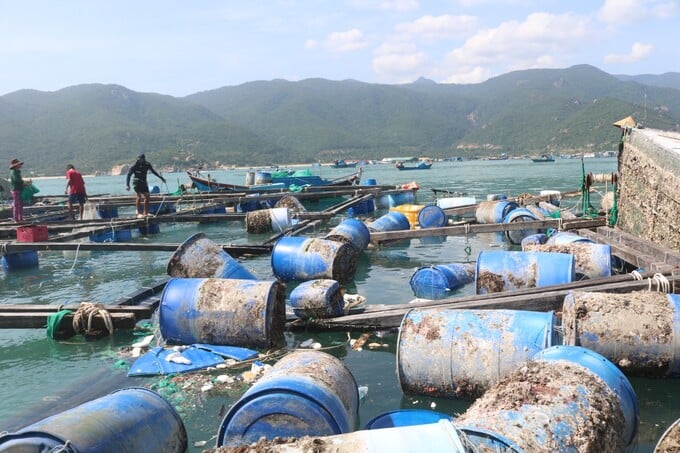November 19, 2025 | 00:38 GMT +7
November 19, 2025 | 00:38 GMT +7
Hotline: 0913.378.918
November 19, 2025 | 00:38 GMT +7
Hotline: 0913.378.918

Aquaculture cages in the South Central region are made of wood. They are easily damaged by strong winds and big waves. Photo: KS.
With a long coastline, and many lagoons and bays, the two south central provinces of Khanh Hoa and Phu Yen have favourable conditions to develop marine aquaculture.
Vo Khac En, Deputy Director of Khanh Hoa Fisheries Sub-Department, said that cage aquaculture first appeared in the province in 1990 with very few cages. Seeing the economic benefits of lobster farming, farmers were more and more interested in marine aquaculture.
“Thus, the number of cages has increased. Until now, the province has more than 75,000 cages including about 64,500 cages for lobster and 9,740 cages for marine fish. The cage farming area is concentrated mainly in four localities of Van Ninh, Cam Ranh, Ninh Hoa, and Nha Trang city,” En said.
Similarly, in Phu Yen province, cage aquaculture has been formed for over 30 years.
According to the Phu Yen Department of Agriculture and Rural Development, the province now developed more than 1,600ha of water surface to raise species such as lobsters and marine fish. Lobster farming areas are mainly in lagoons and bays like Xuan Dai, Cu Mong (Song Cau town), coastal open seas in An Ninh Dong, An Hoa, An Hai, and An Chan communes (Tuy An district), and Vung Ro bay (Dong Hoa town).
However, fishermen in Phu Yen Province now raised marine fish with their own experience and outdated farming technology. Specifically, they still use wood or bamboo to make cages.

Fishermen raise fish in cages based on experience, outdated farming technology, and rudimentary cages. Photo: KS.
Similarly in Khanh Hoa Province, marine farmers also follow the traditional process, on a small scale. Most cages are made from traditional wood materials. As a result, they are unable to respond to big waves, and strong winds and have not yet adapted to climate change impacts.
Currently, in this province, only three units and enterprises raise marine fish with HDPE cages with Norwegian technology.
On the other hand, cage farming areas in the area are mainly near the shore and along the island in lagoons and bays. Most fishermen use fresh food and the density of farming in the farming areas are not guaranteed, which possibly pollutes the environment.
At the Agricultural Extension Forum@Agriculture with the topic "Development of sustainable marine fish farming, adaptation to climate change" recently held in Nha Trang City, Nguyen Huu Dung, president of the Vietnam Marine Farming Association also assessed that the challenges in developing marine aquaculture in the central provinces are that most of them are small-scale farms with outdated technology. Few enterprises are interested in investing in marine farming.
Especially cages which are mainly made of wood and bamboo, are easily damaged by level 7 wind, not to mention storms with level 11-12 wind.
Khanh Hoa and Phu Yen provinces suffered heavy damage due to typhoon No. 12 in 2017. According to the Phu Yen Department of Agriculture and Rural Development, the storm damaged nearly 90,000 cubic metres of cages, killing more than 788,000 commercial shrimp and nearly 22,000 nursery lobsters.

Aquaculture cages were broken by big waves on Binh Hung island, Cam Binh commune, Cam Ranh city, Khanh Hoa province. Photo: KS.
The storm also caused losses worth more than VND 11 trillion to Khanh Hoa province’s aquaculture sector.
The cage aquaculture area on Van Phong bay, Van Ninh district was hit hardest as for years, people still used cages made of bamboo, wood, iron, and steel. The cages had small sizes with a capacity of only 96 - 125 cubic metre each.
The disadvantage of these cages is that they can only be used in areas with slow flow and little waves. They can be used for only about five years, so the investment efficiency is not high.
Pham Ngoc Luyen, Deputy Head of the Economic Department of Van Ninh district, said that when storm No. 12 hit the district, about 50,000 cages of local fishing farms were damaged, claiming total losses of about VND3 trillion.

Aquaculture fishermen in Binh Hung see cages broken after the storm. Photo: KS.
By the end of last year, aquaculture farmers in Binh Hung Island, Cam Binh Commune, and Cam Ranh City suffered damages caused by the ninth storm of the year.
According to the report of Cam Binh Commune People's Committee, storm No. 9 damaged 2,472 cages, sinking two boats and 1 canoe.

Facing the challenges of climate change, aquaculture fishermen must change to further adapt to natural disasters and avoid damage. Photo: KS.
Increasing challenges of climate change, storms, big waves, and strong winds pose higher risks to fishing farms that use traditional wooden cages. Therefore, it is a must for fishermen to change their farming methods to both adapt to climate change and ensure economic benefits, as well as promote sustainable aquaculture.
At the end of March and early April, Phu Yen province experienced unusual wind and rain that damaged 2,450 cages with 790,000 lobsters. Therefore, it’s an urgent need to find new materials to make cages so that marine aquaculture could be better respond to natural disasters.
Translated by Hien Anh

(VAN) SEIKI Group envisions itself as a pioneer in the ‘dual transformation’ of digital technology and green industry, standing alongside the Government and Vietnamese businesses in their pursuit of sustainable development.

(VAN) The VNGEONET network affirms Viet Nam's progress in mastering digital space, providing a precise positioning data platform to serve socioeconomic development.
/2025/11/14/3247-1-184556_35.jpg)
(VAN) Thai Nguyen is methodically implementing digital transformation in the livestock sector, laying the foundation for a modern, transparent, and sustainable agriculture.

(VAN) The year 2025 marks 80 years of development of the Agriculture and Environment sector, a proud journey with significant progress in production, integration and sustainable growth.

(VAN) De Heus continues to steadfastly pursue sustainable development, building linked value chains with farmers and businesses in Viet Nam.

(VAN) From the rich lands of Co Do (Can Tho), an enterprise is amplifying the value of the clean rice grain, a symbol of the vitality and pride of the Mekong Delta.

(VAN) The Vietnamese irrigation sector has undergone a remarkable transformation, becoming a proactive force in disaster prevention, climate adaptation, and risk management in the era of climate change.